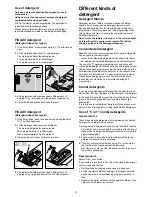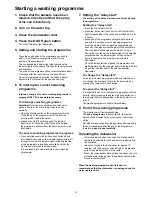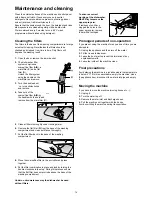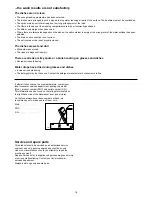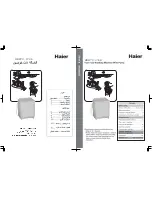
17
Any electrical and/or plumbing work required to install
this appliance should be carried out by a qualified
electrician and/or plumber or competent person.
Remove all packaging before positioning the machine.
If possible, position the machine next to a water tap and a
drain.
Fitting under a counter
(kitchen worktop or sink)
By removing the machine’s worktop, you can install it under a
close fitting sink unit or a pre-existing top, providing the
dimensions of the recess correspond to those shown in the
picture.
Proceed as follows:
Remove the machine’s worktop by unscrewing the two rear
retaining screws, pull from the front and slide out the rear
slots, lifting the worktop.
Insert the machine after adjusting height and levelling with the
adjustable feet. When inserting the machine, ensure that the
water inlet and drain hoses are not kinked or squashed.
If the dishwasher is later used as a free-standing appliance,
the original worktop must be re-mounted.
The plinth on free-standing appliances is not adjustable.
Levelling
Good levelling is essential for correct closure and sealing of
the door.
When the appliance is correctly levelled, the door will not catch
on either side of the cabinet.
If the door does not close correctly, loosen or tighten the
adjustable feet until the machine is perfectly level.
Water supply connections
This dishwasher may be fed with either hot (max. 50°) or cold
water. Nevertheless we advise you a cold water supply.
A hot water supply is not always efficient with very soiled
crockery as it shortens the washing programmes a lot.
The dishwasher must not be connected to open hot water
appliances or instantaneous water heaters.
The dishwasher is fitted with safety devices that prevent the
wash water returning into the drinking water system and
comply with the applicable plumbing regulations.
The water pressure must be within the limits given in the
technical specifications. Your local Water Authority will advise
you on the average mains pressure in your area.
The dishwasher features fill and drain hoses which can be
turned either to the left or the right to suit the installation.
The water inlet hose must not be kinked, crushed, or entangled
when it is being connected up.
Do not use, for connection, old hoses which have been
used in another appliance.
If the machine is connected to new pipes or pipes which have
not been used for a long time, you should run the water for a
few minutes before connecting the inlet hose.
Water inlet hose with safety valve
After connecting the double-walled water inlet hose, the safety
valve is next to the tap. Therefore the water inlet hose is only
under pressure while the water is running. If the water inlet
hose starts to leak during this operation, the safety valve cuts
off the running water.
Please take care when installing the water inlet hose:
- The distance between the bottom edge of the safety value
and the floor on which the dishwasher is standing must be at
least 30 cm:
- The electrical cable for the safety valve is in the double-
walled water inlet hose. Do not immerse the water inlet hose
or the safety valve in water.
- If water inlet hose or the safety valve is damaged, remove
the mains plug immediately.
- A water inlet hose with safety valve must only be replaced by
a specialist or by the consumer services department.
- Place the water inlet hose in such a way that it is never
higher than the bottom edge of the safety valve.
Installation instructions
820
570 - 600
600
IN05
CS19








